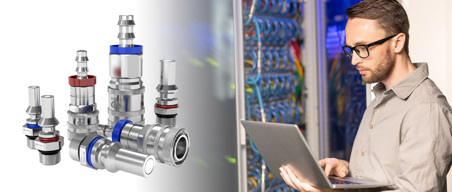Thermal management for safe and efficient fast-charging of battery electric vehicles on the road

The interest in battery electric vehicles (BEV) is increasing. Yet, a continuous challenge is the availability of fast-charging stations while being on the road. In order to reduce charging time, the charging power needs to go up. As a result of this, the heat will rise significantly. To efficiently dissipate the heat and enable fast charging, controlled thermal management with liquid cooling is needed.
Most of the time, water and electronics do not mix, but increasing power output and circuit density in electronic systems has required more modern and effective ways of dissipating heat.
Today, there are mainly two challenges when it comes to the ability of fast charging Electric Vehicles (EVs). First, the availability of charging stations on the road. Mostly, EV’s are being charged at home or work, but whenever outside those areas, it is much harder to find a fast-charging station. The second challenge is the charging speed.
A typical 22 kW AC charger provides enough charge in 120 minutes to provide an additional 200 km of vehicle range (per article in Automotive Power). To reduce the 200 km range charge time to only 16 minutes, a 150 kW DC charging station is required. At this level of power, and to avoid overheating, an effective and improved thermal management is needed as the temperature can increase to more than 270°C during a 10-minute fast charge, according to a report from the U.S. Department of Energy.
Liquid cooling reduces charging time
Traditionally, air cooling has been the preferred solution, but with the fast-moving development, liquid cooling has been shown to be the most effective as air cooling systems charges more slowly. The heat capacity of water is also 3,500 times more efficient than the same volume of air, and up to 10 times more effective at dissipating heat from the source. Furthermore, liquid cooling enables working with pre-filled systems, which will facilitate the maintenance, expedite any necessary replacements, authorize quick initial installation, and expedite upgrades.
Liquid cooling can be found in many application areas. Among those, thermal battery pack, vehicle inverter, vehicle e-motor charging cable and charging station power electronics.
Quick connect couplings a key component in liquid cooling systems
In a field where uptime and reliability are the keys to success, utilizing high-quality components is highly important. Just as overheating, leakage in an electronic system is a common worry in case of an accident. Using quick connect couplings, which is a key part in a liquid cooling system, designed for long-term reliability with high flow and low-pressure drop, minimizes these risks.
CEJN ultraFLOW, a series of fluid couplings with a flat-face design, guarantees no-spill, high flow, and low-pressure drop. Using a non-drip coupler like ultraFLOW, outlined for a clean connection and disconnection, will extend the hardware life and keep running costs low.
Three reasons to choose CEJN ultraFLOW:
- Guaranteed no-spill, high flow, and low pressure drop
- Leak tested to ensure reliability
- Available in hard-coated high strength aluminum to make them lightweight or in stainless steel for corrosive environments
Read more about ultraFLOW and our solutions for thermal management >
Did you know…
- That Oslo, Norway, with a population of five million citizens, are leading the EV charging infrastructure and ownership in cities outside China per capita? Approximately there are 230,000 EV’s in the country.
- That charging at level 1, 120V, takes six to ten hours, charging at level 2, 204-240V, one to three hours, and DC fast charging, 480V, only 30 minutes?
Source: https://cities-today.com/fast-facts-electric-vehicle-charging/
Quick Connect Couplings:
A Critical Component in Liquid Thermal Management Solutions
Related Stories

Shaping the future of liquid cooling technology in data centers: CEJN and the Open Compute Project (OCP)
The data center industry is undergoing huge technology shifts at a rapid pace. With advanced technologies demanding more power and efficiency, greater stress is put on thermal management systems. To meet the increasing cooling requirements, CEJN is actively contributing to the Open Compute Project (...

Universal Quick Disconnects (UQD) – open standard couplings now available in two sizes
CEJN now has two sizes of the UQD universal quick disconnects available. It is a reliable and easy-to-use quick coupling for liquid cooling in data centers developed upon an initiative by Intel as an...

PON Equipment builds world’s biggest battery-electric excavators – equipped with CEJN ultraFLOW
Pon Equipment, the Norwegian dealer of Caterpillar machines, is now bringing heavy-duty battery-electric excavators of 12 and 25-tons into the global market. At this level of power, an efficient...
